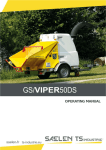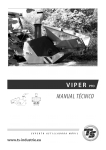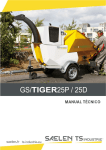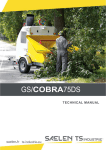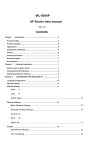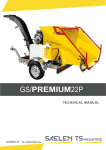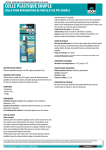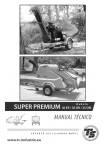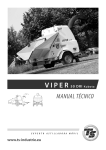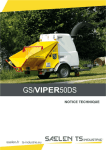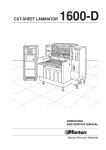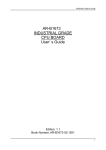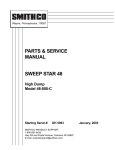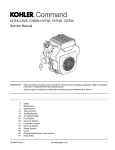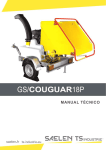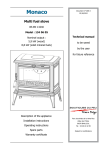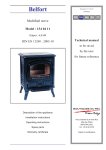Download TECHNICAL MANUAL
Transcript
TECHNICAL MANUAL SOMMAIRE Declaration of conformity Caution Warranties Invention patent Foreword Location of the serial number Safety regulations Pictograms Security transport General description and operations Feeding marerial Attachement to a vehicule Checklist before starting Starting Instruction for the shredding Putting out of service Bio lubricants Lubricants: types and quantity Maintenance intervals machine Removale crankcase and opening engine hood Lubrication points Oil levels Adjusting the tension of the assembly conveyor run Checking conveyor run and plate Rotor ventilation holes Disassembly to replace the blades and the hammers inserts Disassembly to check the counterblade Adjusting the rotor belts Engine dashboard TIGER DR Inductive sensor Protection fuse The safety access rotor (ER and DR) and opening motor cover (DR) Emergency stop buttons PILOT SYSTEM The tanks hydraulic oil and fuel Evacuation shaft Problem - Solving Hydraulic diagram Specifications 4-5 6 7 8 9 10 11 - 13 14 - 16 17 18 - 20 21 22 22 23 24 25 26 27 28 29 30 - 31 32 33 34 34 35 - 36 37 38 39 40 40 41 42 43 - 52 53 54 55 - 56 57 58 DECLARATION OF CONFORMITY The TS industrie Company Weserstrasse 2 47506 NEUKIRCHEN-VLUYN Tél : +49(0)2845 9292-0 - Fax : +49(0)2845 9292-28 HEREBY DECLARES THAT THE MACHINE : TS Trademark: industrie Type : TIGER 25 ER Engine power: 18,5 kW Technical documentation detained by Mathieu Willerval. that the product is in conformity with the following European directives: - 2006/42/CE “ EG-Maschinenrichtlinie” Norm - 2004/108/CEE “Elektromagnet” Norm - 97/68/CE “Vergiftung” Norm - 2000/14/CE “Schall” Norm Conformity appraisal process concerning directive 2000/14/CE Appendix V. Installed power at 3600 rpm Measured Noise Power Level Guaranteed Noise Power Level (Lwa) 18,5 Kw 124 dBA 126 dBA References of harmonized standards used: - EN 13525 Made in RONCHIN, on September 10th 2012 Mathieu Willerval (Production manager TS-industrie) DECLARATION OF CONFORMITY THE TS industrie Company 3 rue Jules Verne L’Orée du Golf 59790 RONCHIN FRANCE Tel : 0.820.201.880 - Fax : 0.820.201.990 HEREBY DECLARES THAT THE MACHINE : TS TM Trademark: industrie Type : TIGER 25 DR Engine power: 18,5 kW Technical documentation detained by Mathieu Willerval. that the product is in conformity with the following European directives: - 2006/42/CE “ EG-Maschinenrichtlinie” Norm - 2004/108/CEE “Elektromagnet” Norm - 97/68/CE “Vergiftung” Norm - 2000/14/CE “Schall” Norm Conformity appraisal process concerning directive 2000/14/CE Appendix V. Installed power at 3600 rpm Measured Noise Power Level Guaranteed Noise Power Level (Lwa) 18,5 Kw 124 dBA 126 dBA References of harmonized standards used: - EN 13525 Made in RONCHIN, on September 10th 2012 Mathieu Willerval (Production manager TS-industrie) CAUTION! Before delivery of our machines, they go through a strict quality control in the factory. Because the machine is no longer under our influence when it has left the factory, another check by the retailer must be made before delivery to the end customer. The following is to be checked: - External damages due to transport etc. - All screws and hose connections for tightness - Oil, water and fuel filling level - Complete functional control of all parts This inspection is recorded with a stamp and signature on the machine delivery note. There is no claim to warranty without returning the fully completed and signed delivery note! Furthermore, all screw connections must be checked for a tight fit before initial use and the hose lines checked for areas of abrasion! Please directly arrange an appointment with your customer for this. Regular inspections according to the operating manual are to be met! Controlled quality - an important step towards customer satisfaction! Please cooperate! Warranties Processing warranty claims Warranty claims according to the manufacturer's general terms of business are valid for 1 year from the date of delivery. The handover date stated on the machine delivery note is decisive for the time of transfer of risk. Warranty claims are generally to be reported to the contract retailer making the delivery. The recorded parts of the delivered machine must generally be kept without any changes due to the proof reasons until final processing of the enforced warranty claim. In the event of a warranty claim, the claimed part of the machine (or old part) is to be provided free domicile to the manufacturer or the sales retailer. A technical change to the machine and/or parts thereof leads to the loss of all warranty claims. The same applies in the case of incorrect handling or use of lubricants or spare parts and accessories not approved or specified by the manufacturer. Transport damages and damages that are caused by normal wear and tear after initialisation of the machine are not usually valid for warranty claims. The delivered machine is to be subjected to the specified obligatory visual checks or inspections according to the specified intervals in the maintenance plan provided. In the event of noncompliance with the obligatory visual checks and inspection plan, all warranty claims are void. A further prerequisite for a warranty claim is the submission of full proof of the obligatory visual checks and inspections performed. Any warranty and maintenance work may only be performed by a specialist retailer authorised by TS. It is pointed out that the warranty work exceeding a value of 150.00 € must generally be coordinated with TS and approved by TS. The manufacturer reserves the right to perform the repair himself in this case. A prerequisite for enforcement of a warranty claim is the return of the fully completed and signed machine delivery note. It is not allowed to modify equipment and electronic programming in any way whatsoever. Unauthorized modification could affect the operation or safety and possibly shorten the life of the equipment. DO NOT FORGET TO REGISTER YOUR GUARANTEE OTHERWISE IT WILL BECOME INVALID. http://www.saelen-industrie.com/AN/professional.php ou en nous retournant le carton de garantie fourni avec la machine PATENT FOR INVENTION Intellectual property law-Books VI GRANTING DECISION The General Manager of the National Institute of industrial property has decided that invention patent # ##-##### the text of which is appended shall be delivered to: SAELEN S.N.S. Company - FR The delivery produces its effects for a period of twenty years starting on the date of deposit of the application, under reserve of payment of the annual royalties. Mention of the delivery is made in the Official Bulletin of industrial property ###/## of ##:##:## (publication # # ### ###). Foreword We thank you for your decision to purchase a TS Industrie wood shredder. Your TS Industrie wood shredder has been produced with great care to high quality requirements. In order to satisfy these requirements, including professional requirements, we ask you to read this operating manual conscientiously and comply with the warning and maintenance instructions. We can only provide the full manufacturer's guarantee for the TS Industrie wood shredder with compliance of all maintenance work at the specified intervals. This operating manual covers several models so the introduction explains how you can find your way around with the help of little pictograms. Location of the serial number When ordering spare parts for replacement or if you need technical information, please always have with you the serial number of your TIGER shredder. TS industrie manufacturer’s plate is on the front left chassis. The serial number is located at the place indicated on the photo. Serial number Safety Regulations 1. The machine may only be used according to the operating manual. 2. The operating manual for the drive motor must also be taken into account for motor machines. 3. Folding up the extraction extension (if it exists) may only be performed with the hacking disc at a standstill. 4. Maintenance, cleaning and setting work, as well as removing protective devices, may only be performed with the motor switched off, ignition switched, uncoupled drive (machines PTO) and tools standing still. Remove the ignition key so that unintentional start-up is not possible. 5. Foreign matter, e.g. iron parts and stones etc, must be removed before operation. 6. After maintenance or repair, check whether all protective devices have been attached. 7. The wood shredder may not be taken into operation in rooms due to the associated risk of poisoning. 8. The hacking disc may only be removed once it has come to a standstill. This means that the drive motor is switched off and the ignition is in the 0-position. 9. The machine operator is responsible for making sure that third parties are not in the work and danger zone. 10. In the event of repairs, make sure that only original tested spare parts are used. 11. Only trained persons from 18 years may operate the wood shredder (from 16 years for the purpose of training, under supervision). 12. Safety footwear and closely fitting clothes as well as work gloves with close fitting cuffs, ear protectors and goggles must be used. 13. For transport, the wood shredders must be brought into the transport position: A) Lift up the funnel flap and check whether the lock has clicked in. B) Take the wood shredder into the transport position and check whether the security bolts are clicked in. C) Turn the ejection channel so that it does not protrude beyond the side of the machine. D) Push all parking locks up if necessary 14. When driving on public roads, the lighting must correspond with the England Traffic Road Regulations. 15. When working, the wood shredder must be positioned steadily in a horizontal position and must be secured against rolling away. 16. Single axle motor devices are attached to traction vehicles and, if available, the park brake is applied. For operation without a traction vehicle, the parking locks (front and back) must be lowered. 17. Minimum clearance of 10 m from the machine to the ejection must be maintained due to safety reasons. The objection must always be averted by operating personnel 18. You may only reach into the retraction opening with your hands when the motor has been shut down and the hacking disc has come to a standstill engine stopped. 19. The authorised hydraulic operating pressure set in the factory may not be changed 20. Only trunks up to 5,51 inches diameter may be processed in the wood shredder. 21. The hydraulic system must be subjected to an expert inspection every year. The hydraulic hoses are to be replaced after five years. 22. Do not reach into the supply funnel when filling the wood shredder. Blockages must be dealt with safely (stop motor, use aids). To push short pieces or branch-like hacking items through, only use sturdy wooden sticks or other aids made of wood. I will wood shredders are only suitable for manual loading. Do not move around the ejection area. 23. Perform a function test every day before initialisation, especially on the safety equipment (tightening of the wheelhouse wheel, lock covers, safety switches cowlings and access chimney). Hacking blades and counter blades are also to be tested for function and a tight fit. 24. Operating personnel must be inducted thoroughly before initialisation. 25. The hacking disc may only be released once it has come to a full standstill and the motor has been switched off. 26. Danger due to flying parts. Attention must be paid that parts such as wood chips can also fly out of the funnel in the operating area. Body protection must always be attached. The machine should be operated to the side of the funnel. 27. Information for all motor machines: The tilted position of the motor may be a maximum of 25° during operation (driving). With too little oil, lubrication of the motor is not even guaranteed at 25°! 28. Take care on slopes. The machine driver must ensure that the machine is always safely driven and is kept steady and safe during work. 29. After coupling the machine to the tractor, lift up, or better to remove the jockey wheel. 30. The machine may only be loaded with wood. Make sure that no stones or metals enter the machine. 31. The machine may not be used to transport goods or persons. 32. The machine may not be used to push or pull anything. 33. The battery acid is very corrosive. Avoid all contact with eyes, skin and clothing. In case of contact, rinse immediately with water and ask for medical advice if necessary. 34. Before connecting the machine to the power net, the cable linked to the positive side of the battery must be removed. 35. Interventions must be handled by a qualified technician. All interventions for assembly, disassembly and/or specific maintenance must be handled by a recognized distributor. Pictograms Wear goggles! Wear ear protectors! Wear protective gloves with special close fitting cuffs! Wear safety footwear! Only touch machine parts when they have come to a complete standstill! Maintain a sufficient distance from rotating machine parts! Pictograms Never open and remove protective devices with the drive running! Read the operating manual before initialisation! Do not remain in the ejection area when the machine is running! Danger zone! Switch the motor off and remove the key before maintenance and repair work! Attention! Grip wheel. Never enter the hopper when the engine is running. Fill fuel tank with petrol Fill fuel tank with diesel Pi ctograms Hydraulic oil to use : HV46 Lubrification points Maximum engine speed Minimum engine speed The noise level of the machine at work does not exceed the standard shown on the sticker on the machine Rotation commands of the conveyor belt: Chipping material (forward operation to the maximum speed) Stop the rotation of the feed rolls Releasing material (backward) Sécurity transport 1) Comply with the traffic code. 2) Check if the signalisation lights of the equipment are appropriate and in working order. 3) Lower your speed on uneven roads and surfaces. Wear of the coupling: Check the wear indicator when coupling the machine. Systematically repleace the had and/or the ball of the coupling of the vehicle if the indicator is in the MINUS zone. You might loose the chipper on a bump in the road or against a border. YOU ARE RESPONSIBLE IN CASE AN ACCIDENT HAPPENS. Head and/or ball of the coupling OK Head and/or ball worn Coupling to the vehicle: Always couple the chipper horizontally to avoid the backward transfer of the mass AND check daily whether the two bolts of the coupling axis are still tight in order to prevent shocks that might affect the life span of the axis and the trailer. General description and operations DESCRIPTION MACHINE The TIGER TS IndustrieTM multi-vegetation chipper is suitable for chippping vegetable waste and branches of a maximum diameter of 5,51 inchs. The chipper consists of the following main parts: (A) : the frame (B) : the chipping cell (C) : the engine with its transmissions (D) : the discharge chute (E) : sound insulation (F) : assembly conveyor band General description and operations A. The frame The frame of the chipper supports the different parts of the TIGER. It allows the autonomous transportation of the machine. B. The chipping cell The chipping cell consists of a hopper (1), a metal belt (2), a feed roll (3) with notched rods and a rotor that crushes the material. Feed belt and roll: They transport material to the rotor at a constant speed. A blocking system stops them when the rotor speed is too low (blockage during chipping) and they start automatically when the rotor has reached a sufficient speed again. They can be operated in both directions (forward and backward) using the yellow and black buttons at the back of the hopper. The rotation speed can be set using the wheel (4) in the cover at the back left according to the diameter of the material. Rotor: The rotor is the main part of the machine that crushes the material that is fed by the feed roll. It rotates by accelerating the engine and rotates continuously . General description and operations C. Engine and transmissions The thermal engine is located above the chipping cell. It supplies the necessary energy for driving the rotor and the oil pump (1) of the hydraulic circuit. The gasoline and diesel engine is a three-cylinder diesel engine capable of 25 hp at 3600 r/min. For more information on this engine, please refer to the manufacturer’s manual. The axis is equipped with a 2-belt pulley to drive the rotating movement of the chipping engine. The oil pump of the hydraulic circuit activates the hydraulic engines of the feed belt/roll. D. The discharge shaft This discharges the shredded material. The upper part can be swivelled 160° in a horizontal position. Its cap is adjustable in a vertical position. Note: Residues of wood chips can be ejected at the start of the shredding. Electrical safety stops the motor and prevents it from starting if the chimney is opened to access the cutting rotor Zone de commande Zone de danger Zone optimale De rotation E. Covers Tiger ER and DR and cover motor Tiger DR. Two hoods machine and cover motor protects the moving parts of the machine allows the user to work safely. One electrical safety stops the engine and prevents it from starting if the hood motor is raised. Functioning and execution FEEDING MATERIAL The Tiger is equipped with an electrically operated hydraulic distributor that is activated using the two buttons at the back of the hopper for forward and backward operation and the red operation handle to stop the feed belt and roll. REM.: the engine must run at maximum speed in order to rotate the feed belt and roll. FORWARD OPERATION: 1: For the forward operation of the roll, set the red handle at its must backward position. 2: Push the yellow button to make the roll run forward. STOP FEED: 1: Push the red bar to stop the feed. BACKWARD OPERATION: 1: Set the red handle at its back position. 2: Push the black button. REM: the feeding cell can be switched directly from forward to backward operation and vice versa without using the operating handle. Functioning and execution Attachment to a v ehic le When attaching the wood shredder to a vehicle, you must proceed as follows. Set the support wheel at the height of the drawbar so that the trailer tow bar is over the one on the vehicle. Now turn in the support wheel and the opened ball-head coupling must click into the ball on the tow bar. Please check that it is clicked in! Then connect the catch line to the vehicle and plug in the plug for the lighting. Fully retract the support wheel, push the back safety support up, lock and check the lighting. The support wheel may only be unscrewed up to the marking. In the coupled status, the display must be within the green range. (see page 17). CHECKLIST BEFORE STARTING Each operator must read and understand the instructions and must take the safety precautions as described in this part in order to operate the chipper in a safe and efficient manner. The operator has a checklist for use. It is important to use it for safety reasons but also to maintain the machine in a good condition. Before starting the machine, please check the following items: 1) Has the machine been lubricated sufficiently in accordance with the schedule in the user manual? 2) Check the different engine levels, and in particular: Engine oil Radiator fluid Fuel 3) Check the oil level of the hydraulic circuit 4) Check if the air filter is clean 5) Check of the radiator of the engine is clean and free 6) Check of the covers have been closed well 7) The wood shredder may only be used outdoors, not inside rooms, due to the danger of poisoning from the drive motor and the wood dust from the wood shredder. 8) After setting and blocking the chimney cap and eject, only the operator is authorized to change their positions. Functioning and execution ATTENTION ! If for any reason, the chipper has difficulties chipping the material and you need to stop it: do not restart the engine without removing the blockage and removing the material from the rotor!!! Oper ation A steady base is to be ensured before initialisation (place any brake wedges is in front of the wheels 1) Check whether the cover above the chute is open. 2) Set the engine to idle position. 3) Preheat 10 secondes (DR), engage the starter (ER), and start it by turning the ignition key 4) Carefully accelerate the engine speed and let the engine reach its working temperature. 5) Accelerate the engine to maximum speed.(see note on SLIPPAGE page 48) 6) Rotate the roll forward by pushing the yellow button left the hopper. 7) Start shredding Material handling and insertion INSTRUCTIONS FOR THE SHREDDING Attention must be paid to solid base for operating personnel! Place the hacking items onto the base of the funnel and guide the thicker end (trunk) to the retraction roller (taper off thick trunks at the end) As soon as that have taken the material, step to one side because even as in the trunk can lead to flying particles. The material is now automatically shredded and pushed in the direction (distance) previously adjusted for the ejection channel. After entering the material, you should occasionally check the ejection of the chopped wood and possibly readjust the direction of ejection. The width of the ejection is controlled by the ejection flap (see page 20) When hacking splinters, bark and branches, you can avoid the formation of splinters by guiding the material into the retraction chute next to each other lengthways. If no more retraction takes place (blockage due to excessive material or branch forks), press the switch black "reverse" position (rollers turn backwards) and the hacked items are pushed back. Now shred the material quantity or saw off branch forks and start loading again. The hopper can be cleaned with the aid of a wooden material. Caution: Do not reach into the funnel when the machine is running! Push small pieces of wood through using a wooden stick or pusher if necessary! Never push the hacked material through the funnel with a metal rod or metal pusher! It is also forbidden to remain in the danger zone! With particularly strong or hard wood, it makes sense, depending on the motor power, reduce the speed of rotation of the feed roller if the speed drops so that the motor can achieve the nominal speed again. The cover may only be opened and stuck pieces of wood removed with a suitable tool only after stopping the cutting rotor and the drive motor Noise emissions The wood shredder produces a guaranteed sound level in accordance with directive 2000/14/EC of: Type TIGER ER TIGER DR Sound level LWA [dB] 126 126 Sound pressure level LAeq [dB(A)] 124 124 Material handling and insertion Putting out of service 1) Let the chipper empty itself of all remaining materials from the feed roll and the chipping cell to avoid the rotor getting blocked with the next start. 2) Push the operating handle forward to stop the feed roll and belt. 3) Set the gear handle to idle position. 4) Stop the engine by turning the ignition key on the operating panel. Maintenance and Service BIO LUBRICANTS TO REDUCE THE RISK OF POLLUTION TS INDUSTRIETM chippers and chipper-shredders enter into the sustainable development classification for their production of compost, mulch and heating solutions. Forests, parks, sites in proximity to lakes and rivers … TS INDUSTRIETM chippers and chipper-shredders are often used in areas where other machines represent a hazard for the environment through risk of leakage and hydraulic fluid loss. For this reason, TS INDUSTRIETM has adopted an eco-friendly attitude by equipping its chippers and chipper-shredders with bio-degradable lubricants: an association of high performance with environmental impact reduction through the replacement of traditional oil and grease. Conform with the agricultural directive 2006/11/EC against pollution to the aquatic environment, published on the 06/01/2006. The pros of Bio Lubricants: - Prevents risk of environmental pollution - Increased biodegradability - Non toxic (rape seed and sunflower oil base) - Renewable - Very high viscosity - Reinforced corrosion, wear and rust proofing - Increased security for the user - Increased part life - Low volatility Maintenance and Service SAFETY PRECAUTIONS 1) Stop the machine, remove the ignition key and wait for all moving parts to come to a stop before proceeding with maintenance interventions or repairs. 2) Do not forget to put all the safety screens back after the intervention. All machines are test driven before they leave the factory. The hydraulic tank is filled with hydraulic oil up to the top mark of the sight glass before delivery. After 50 operating hours, the filter must be changed. Changes are made after this in accordance with the maintenance schedule. The first inspection is part of the warranty condition. Only trained personnel may be deployed for maintenance and repair work. The enclosed motor manufacturer's operating manual is to be taken into account for motor maintenance. LUBRICANT quantity: Gasoline engine: 1,3 l. Diesel engine: 3,7 l. Fuel: 18 l. Hydraulic oil: 8,5 l. Recommended LUBRICANT: 1) Lubricant for the hammers of the rotor: You must use a water-resistant lubricant of type NLGI grade 2 "SAELEN BIOPLEX " 2) Lubricant for bearings, transmission belts and different organs: Use a versatile high grade SAE lubricant that is compatible with extreme pressures "SAELEN BIOPLEX " 3) Hydraulic oil: Use oil AFNOR NFE 48600 Types HV iso VG 46 "MINERVA BIO HYDRO 46 " 4) Engine oil Use SAE 15W40 which complies with the standards: API CH4-CG4-CF "MINERVA POWER LONG WAY 15W-40 " Maintenance and Service FREQUENCY OF MAINTENANCE ENGINE: see the manufacturer's maintenance manual engine MAINTENANCE INTERVALS MACHINE Hours Interventions -Control-tightening two nuts serrated articulation hitch Daily -Check operation of safety-punches and handrail red -Check oil level engine -Check fluid level radiator (DR) Control-clean honeycomb radiator (DR) Hitch-control vehicle / trailer (see p.17) Check tightness of wheelLighting-control -All fixing screws are to be checked for a tight fit The first time after 4 am -Check the tension of the rotor transmission belts -Check the tension of the metal belt -Control tension belt oil pump (DR) (moderate tension) (voir p.38) Every 10 hours -Lubricate rotor hammers and verification wear rings -Lubricate the two rotor bearings Every 50 hours -Check if the air inlet below the rotor is clean -Check the blades and the hammers -Check the tension of the rotor transmission belts and belt oil pump (DR) -Lubricate the bearing of the feed roll -Check the hydraulic oil level -Check and remove the branches winding around the bearings' axes and the hydraulic motors -Check the tension of the metal belt -Lubricate the bearings of the F and B rolls of the metal belt Every 150 hours -Replace the hydraulic oil filter for the first time, then every 500 h (or 2 years) -Check the counterblades for wear Every 300 hours -Check for wear of belt and gliding plate -Check the electrolyte level in the battery -Replace the hydraulic oil (or every 2 years) Every 500 hours -Replace the hydraulic filter of the return (or every 2 years) -Replace the hydraulic oil suction filter in the tank Maintenance and Service REMOVAL CRANKCASE AND OPENING ENGINE HOOD Maintenance, cleaning and setting work, as well as removing protective devices, may only be performed with the motor switched off, ignition switched, uncoupled drive and tools standing still. Remove the ignition key so that unintentional start-up is not possible. The side housings are held in place by a nut and bolt. Use a 13mm (1/2”) spanner. The engine housing has a lock to each side. These locks can only be opened using the special key delivered with the machine. On opening the housing to access the engine, an electronic security system cuts the engine and/or disengages the starter motor (see page 41) A support rod is used to maintain the housing open. Maintenance and Service LUBRICATION POINTS Lubricate and maintain the machine after the engine has been shut off and the ignition key removed LUBRICATE THE HAMMERS: In order to gain access to the rotor: -Remove the two Nylstop nuts -Open the chute by rotating it on the articulation -Clean the lubricating areas behind the hammer with a small screwdriver or blowing device -Lubricate the 20 hammers Note: do not lubricate extensively, ~2 pumps per lubrication point are enough. Exaggerated lubrication could project excess lubricant to the interior wall of the chute when the rotor turns resulting in problems with transporting chipped material. LUBRICATING THE ROTOR BEARINGS Maintenance and Service LUBRICATION POINTS LUBRICATING THE FEED ROLL BEARING LUBRICATING THE TWO ROLL BEARINGS IN FRONT OF THE METAL BELT LUBRICATING THE TWO ROLL BEARINGS BEHIND THE METAL BELT Maintenance and Service OIL LEVELS LEVEL IN THE HYDRAULIC TANK ENGINE OIL GASOLINE MOTOR ENGINE OIL DIESEL MOTOR Maintenance and Service ADJUSTING THE TENSION OF THE ASSEMBLY CONVEYOR RUN 1 2 3 4 After preparing the belt, check the tenstion for the first time after 4h and then at regular intervals. Maximum tension window 1 Right tension 2 Too loose 3 In order to tighten the belt, you must loosen the four nuts (A) at the side and tighten the tensioners (B) at the same time so the belt does not exceed the base of the cell (see picture 1). Tighten the screws .(A). Rotate the blet forward and backward a few times to check its correct position. Note: do not tighten too much, a good grip of the feed roll and belt does not require excessive tension. Use the maximum tension window (photo 4) N.B.: Avoid feeding earth sodden root matter into the machine. This may clog up the feed conveyor slats and accumulate on the feed roller; thus the feed roller diameter increases causing blockage. Front roller Maintenance and Service CHECKING CONVEYOR RUN AND PLATE 1 2 In order to check the wear of the belt and the self-lubricating polyethylene plate, loosen the belt, lift it with a hook and check: 1 The thickness of the plate above the four fixation screws 2 The wear of the bars of the belt ROTOR VENTILATION HOLES The TIGER has an air inlet below the rotor and two more at both sides of the cell for optimal ventilation. Regularly check if these three air inlets are clean in order to optimize the discharge of chipped materials from the chute. Maintenance and Service DISASSEMBLY TO REPLACE THE BLADES AND THE HAMMER INSERTS Remove the ignition key before proceeding -The hollow hexagonal screws of the blades and hammer inserts are mounted in the facture using LOCTITE normal 243. Use the appropriate wrench that is in good condition to remove them. -Open the chute as described on page 25. -Remove the screws from blades and inserts. (For the assembly later on, only use new and degreased screws). -Clean the contact surfaces of the blades and the inserts clean at the base (1) as well as the wall (2). -Install identical or newly ground blades. IMPORTANT: the blades must be ground by a professional using specific tools, and not with a grinding disc. Make sure tha 35° angle of the cutting edge is respected. The minimal lengt of A should not be smaller than 50 mm after grinding. (The length of a new blade is 60 mm). (next) Maintenance and Service -Tighten the screws using Loctite with a 16b M/kg tightening torque and make sure the blades and inserts lean against the wall A tightening torque of the screws is essential to prevent their accidental unclamping -Lubricate the axes of the hammers (pump ~2 x per hammer). -Close the chute and the covers. -Start the engine and warm it during a few minutes. -Accelerate to maximum speed to make sure no abnormal vibrations disturb the functioning of the machine. - Control blades and hammer inserts - Verification wear rings hammers Inspections every 10 hours Maintenance and Service DISASSEMBLY TO CHECK THE COUNTERBLADE Remove the ignition key before proceeding -Remove the two fixation screws (1) at each end of the counterblade. -Remove the two safety bolts (2) -Move the counterblade from one side of the housing to the other. If the edge shows signs of wear, remove the counterblade and position it again but turned halfway so there is a new edge facing the blades. (The counterblade can be removed from the right as well as from the left side) (The four sides of the counterblade can be used) Maintenance and Service ADJUSTING THE ROTOR BELTS This intervention requires a skilled technician The rotor’s belts are permanently kept extended by an extender. The adjustment of the belts’ tension is done through the pivoting of the engine’s support plate while acting on the extender (1), after loosening the nut (2) and nuts (3) on each side. After belt tension, tighten the nuts (2) and (3). 2 3 1 Nut Nylstop Ø16 Whasher The V-belt is correctly tensioned if the rubber buffer is slightly compressed as shown in the image to left Excessive tension generates excessive pressure on the rubber buffer, as shown in the image to right - After the tension is correct, screw down the locknut up to stop and tighten with one half of a turn. This nut must not be tightened too much, otherwise the rubber buffer becomes distorted, as shown in the image. REGLAGE COURROIE DE POMPE HYDRAULIQUE TIGER DR -- Slightly loosen the 3 bolts supporting the pump. - Use a lever to lower the support. Do not over tension – this may cause breakage of the pump axis. The belt should remain "supple". - Retighten the 3 support bolts. Do not over-tighten the tensioning screw TH8x60, if your machine is so equipped. Description and manipulation ENGINE DASHBOARD TIGER DR A: Green warning light functioning OK (If flashing, the engine stops after 10 seconds ) B: Warning light battery load C: Warning light oil pressure D: Warning light water temperature E: no utility or preheating 8 seconds F: Key switch The engine is stopped automatically if warning light C and D indicate a problem Motor stopped Preheat Start Do not add the key of the chipper to a heavy ring; during functioning this could interrupt contact. The functioning in F and B direction of belt/feed can be reset and the power supply to engine can be interrupted. key the the the Description and manipulation INDUCTIVE SENSOR and PROTECTION FUSE The M18 inductive sensor (Ø18) placed at the end of rotor shaft Indicates the rotation of the rotor to the box Pilot System. NOTE: see page 53 The distance between the sensor and the index must be 0,12 to 0,16in (3 to 4 mm). 40A 15A The protection fuse 12 Volts permanent 15A (Tiger ER) and 40A (Tiger DR) is in the watertight fuse-holder on the starter cable. Description and manipulation THE SAFETY ACCESS ROTOR (ER and DR) and OPENING MOTOR COVER (DR) Chimney safety Tiger ER et DR The engine security cut-off switch (1) is found next to the control box and the magnet (2) is found on the front edge of the hopper. The electrical contact is made when the magnet approaches the sensor. On opening the engine housing, the engine cuts out and /or the starter motor is deactivated. This is indicated by a red LED on the Pilot System (see page 53). Motor cover safety Tiger DR The engine security cut-off switch (1) is found next to the control box and the magnet (2) is found on the front edge of the hopper. The electrical contact is made when the magnet approaches the sensor. On opening the engine housing, the engine cuts out and /or the starter motor is deactivated. There may be no physical contact between sensor and magnet. There must be 0,24 (+/- 0.20) in (6 mm+/-5) play. Description and manipulation EMERGENCY STOP BUTTONS The machine also has two emergency circuit breaker buttons placed at the top of each side of the feed hopper. When they are activated, these emergency circuit-breakers have two functions: 1) stopping the diesel engine 2) instantly stopping the forward run of the feed roller and the belt (The 12V alimentation for the Pilot System and the control box is linked to the emergency stop buttons. When the emergency stop buttons are activated, the engine and the Pilot System cut out, instantaneously stopping both forward and reverse movement of the rotation of the conveyor feed and feed rollers.) Description and manipulation PILOT SYSTEM Available Functions 1. Permanent display of the engine RPM 2. Permanent display of the rotor RPM 3. Permanent display of the total daily hours 4. Permanent display of the total machine hours 5. Green LED indicates that the engine and rotor are turning 6. Red LED indicates fault 7. Hydraulic Test: a rapid forward and reverse action to test the correct function of the hydraulic circuit 8. A rapid forward action of the rotor to test intervention of the NoStress facility 9. 3 NoStress (VarioStress) choices relative to the type of material to be prcessed 10. Maintenance management : intervals for oil change 11. Belt slippage, clutch and hydraulic coupling security system 12. Engine cut-out and starter motor deactivation security system (housing sensors) 13. Default memory settings 14. 21 machine types programmed into memory 15. 4 language options available : English, French, German and Spanish Description and manipulation Description of box Led : Green - static: on Green - flashing: indicates impulsions given by the rotor sensor Red - static: indicates that engine and/or rotor housing is open Liquid Cristal lit screen Engine speed Rotor speed Daily machine hours Total machine hours (since first use) Indicates different phases in use NoStress setting buttons: 1 to 3 Use the Up ↑ and Down ↓ buttons to enter the access code and to navigate the menu It is formally forbidden to modify the default factory settings of the Pilot System. Any modification to the security and program parameters made outside of our factories is the entire responsibility of the person having made these changes. Description and manipulation Choice of NoStress setting As with the VarioStress, the Pilot System has 3 settings. Above each button is a liquid crystal pictogram representing the setting. Button 1 for branch waste: uses a wider engine RPM. Button 2 for leafy waste: uses an intermediate RPM. Can be used for branch waste and small amounts of conifer/vegetation. Button 3 for conifer and large quantities of vegetation (particularly wet and green wood): restricted but high regime for maximum ventilation. If the programme settings are changed during use, the yellow forward button must be pressed to reengage the feed rollers. Description and manipulation Normal and high speed function The rotor speed is indicative of the functioning on the machine. The message RPM too low indicates that the engine RPM, and consequentially, the rotor speed, is not sufficient to allow the forward feed action of the feed rollers. Increase the engine speed to maximum: a smiley indicates when the minimum rotor speed for forward feed action has been reached. The Yellow forward button can now be pressed. Once the feed rollers are in action, if the red stop bar to the rear of the hopper is pushed, feeder stop is displayed. If the rotor speed is too high, the feed roller is automatically stopped to prevent use of the machine and a Danger symbol is displayed along with the message Rotor over speed. To restart the rotation of the feed rollers, the engine must be slowed. It can be returned to maximum only once the cause of the over speed has been rectified. Description and manipulation SLIPPAGE function The Pilot system controls any slippage in the rotor transmission by permanently comparing the speed of the engine pulley in relation to the rotor pulley. A percentage splippage is tolerated in order to proctect the transmission (belts, centrifugal clutch or hydraulic coupler). If the slippage is greater than the allocated percentage, the engine is stopped and a message is displayed on the screen. Different causes of slippage: - rotor blocked at start-up or during operation - belts loose - clutch worn N.B.: Slippage can also occur if the machine is accelerated very slowly from standby. To bypass the message and continue, press the button 1 after having verified and controlled the transmission. The date and time of this message are recorded and saved in the memory of the Pilot System and can be consulted by the mechanic or dealer. Access to CLIENT parameters 1 2 Hold down the ↓ and ↑ buttons for 4 seconds 3 Press the ↑button 3 times to enter number 3, then validate by pressing 1 4 Press again on the button 1 to validate and bypass the second 0 Press the button 1 to validate and bypass the number 0 5 6 Press the ↑ button to enter number 3 et valider avec la touche 1 The user can now access the menus Language, Daily Hour counter, Service Status (services and oil change) and END navigation Description and manipulation Resetting the Daily Hour counter 1 2 Press 1 to validate the deleting of existing hours Press ↓ to scroll to the Daily Hour Counter 3 4 A message validates the operation Press ↓ to scroll to END and press 1 Enter Description and manipulation Service overdue and next service information (engine oil change) When the service is due or overdue, a warning message and an icon show when the machine is turned on. Organise a service with your dealer to carry out the oil change. The message is saved in the Pilot System. To bypass the message and continue work, press the button 1. Press once or twice on the ↓ or ↑ buttons at any time to visualise the next oil change or service, then contact your dealer in advance to make a reservation. Description and manipulation NoStress rotor settings selected Press the ↓ or ↑ buttons once or twice at any time to visualise the rotor settings for the selected NoStress option: Example option 1 below: Minimum RPM: below 1875 rpm the feed roller stops. Return RPM: from 2175 rpm, the feed roller starts to turn. Normal RPM: after over-speed of the engine or rotor (PTO), the rotor must return to less than 2175 rpm in order that the feed roller can function again. RPM overspeed: feed roller stops. REMINDER: It is formally forbidden to modify the default factory settings of the Pilot System. Any modification to the security and program parameters made outside of our factories is the entire responsibility of the person having made these changes. Description and manipulation Rotor access security (ER and DR) and engine housing open (DR) A red LED and a warning message indicate that the rotor access or engine housing is open or has not been correctly closed. The security system stops the engine and prevents restarting (deactivates starter motor). To delete this message, ensure that the housings are closed and press the button 1. Red LED Rotor rotation impulse sensor A static green LED indicates that the machine and, consequently, the Pilot System, have been turned on. The light begins to flash when it receives a signal from the rotor impulse sensor M18. The frequency of the flash varies with the speed of the rotor. Green LED Description and manipulation THE RESERVOIRS The machine has two reservoirs: -the hydraulic oil reservoir 8,5 liters including: -The plug gauge filling (1) -Hydraulic filter on return (2) -The hydraulic filter suction (3) (accessible by removing the suction port) -The fuel tank transparent 18 liters Description and manipulation EVACUATION SHAFT The top part of the discharge chute can be oriented 90° to the left and 90° to the right via the indexer Problem - Solving In this section, we provide a list of problems, their causes as well as possible Solutions. If you experience a problem that is not mentioned here, please contact your reseller. Keep your user manual and the serial number of your chipper at hand. PROBLEM CAUSE SOLUTION The engine stops just after start- -Rotor belts loose or defect with up or during operation and the -Have rotor belts tightened and/or centrifugal clutch or hydraulic coupler clutch or hydraulic coupler controlled by dealer. message slip error is displayed on the Pilot System. -Feed roller speed to high for the type -Reduce the feed roller speed using of matter (too large and hard) the flow divider on the hydraulic distributor. -Engine accelerated too slowly from a -Accelerate more vigorously ticking over. The dashboard and Pilot System -Safety of the emergency button will not turn on activated -Fuse melted 15A. (on the starter -Turn off the safety -Replace the fuse 15A Tiger ER) -Fuse melted 40A. (on the starter -Replace the fuse 40A Tiger DR) The engine will not start -Hood and / or the chimney is open or -Control the closure of the bonnet not closed and chimney -Safety of the emergency button -Turn off the safety activated -The battery is low -The power cables -Load or replace the battery have been -Check the electrical circuits. damaged. -The electromagnet that stops the -Check the electromagnet engine is broken (DR) The motor stops when grinding -Capacitor slammed between large branches terminal 5 and 8 in table startup MC704 -Change the capacitor Problem - Solving PROBLEM CAUSE The engine stops early and will -Safety hood or chimney incorrectly adnot start again SOLUTION -Check and adjust security justed -The red light of the water tempera- -The radiator is dirty: clean ture is on. Reduced engine power -There is no fuel left. -Add fuel -Filter blocked -Replace the filter -Blades and hammers blunt -Grind or replace the blades. Replace the hammer inserts. The belt/roll will not rotate for- -Speed wheel feeding equipment ward or backward -Loosen the setting wheel on the completely tightened --Hydraulic distributor engine or pump defect -Check or replace the defect part -Not enough oil in the tank -Check the oil level 150 bars TIGER Hydraulic diagram Spécifications TIGER 2 5 E R TIGER 2 5 D R Capacity: 5,51 in (14 cm) 5,51 in (14 cm) Hourly output: 17 m3/h 17 m3/h Length: 161,41 in (4,10 m) 161,41 in (4,10 m) Largeur: 64,96 in (1,65 m) 64,96 in (1,65 m) Height: 90,55 in (2,30 m) 90,55 in (2,30 m) Weight without belt: Number of hammers: Between 670 and 664 Kgs with fuels full 10 Between 750 and 744 Kgs with fuels full 10 Number of knives: 2 2 Rotor’s diameter: 15,74 in (400 mm) 15,74 in (400 mm) Rotor’s weight: 45 Kg 45 Kg Rotor’s width: 9,84 in (250 mm) 9,84 in (250 mm) Engine’s power: 25Cv Kubota D902 25Cv Kohler CH730 Gas-oil capacity: 19 L 19 L Engine speed: 3600 Tmn 3600 Tmn Rotor’s speed: 2800 T/mn 2800 T/mn Anti-jamming: YES YES Hydraulic supply: YES YES Hydraulic capacity: 8,5 L 8,5 L Hydraulic pressure: 150 bars 150 bars Road axle: YES YES Soundproofing: NO NO Number of wheels: 2 2 Tyre dimensions: 155/70R13 155/70R13 Tyre air pressure: 2,5 bars 2,5 bars




























































